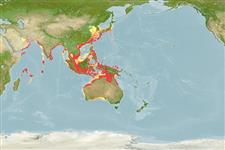>
Eupercaria/misc (Various families in series Eupercaria) >
Sciaenidae (Drums or croakers)
Etymology: Protonibea: Greek, protos = the first + see under Nibea.
More on author: Lacepède.
Environment: milieu / climate zone / depth range / distribution range
Ökologie
seewasser; brackwasser demersal; tiefenbereich 5 - 100 m (Ref. 43239). Tropical; 40°N - 28°S, 47°E - 154°E
Indo-West Pacific: west coast of the Persian Gulf and along the coasts of India and Sri Lanka, north to Japan and south through the Philippines and Borneo to New Guinea and northern Australia.
Length at first maturity / Size / Gewicht / Alter
Maturity: Lm ?, range 85 - ? cm
Max length : 165.0 cm TL (female); common length : 100.0 cm SL Männchen/unbestimmt; (Ref. 9772); max. veröff. Gewicht: 0.00 g; max. veröff. Alter: 8 Jahre (Ref. 72458)
Rückenflossenstacheln (insgesamt): 10 - 11; Rückenflossenweichstrahlen (insgesamt): 225; Afterflossenstacheln 2; Afterflossenweichstrahlen: 7. 7-8 gill rakers on the lower limb of the first arch.
Found in coastal waters over muddy bottoms, off the sea-bed. Ascend tidal rivers and estuaries (Ref. 9772). Feed mainly on crustaceans and small fishes. Also caught with bottom trawls (Ref. 9772). Sold fresh and dried salted (swim bladder) in markets. An important food fish. Minimum depth range based on occurrence (Ref. 118911).
Life cycle and mating behavior
Geschlechtsreife | Fortpflanzung | Ablaichen | Eier | Fecundity | Larven
Lal Mohan, R.S., 1984. Sciaenidae. In W. Fischer and G. Bianchi (eds.) FAO species identification sheets for fishery purposes. Western Indian Ocean (Fishing Area 51). Vol. 4. FAO, Rome. pag. var. (Ref. 3490)
IUCN Rote Liste Status (Ref. 130435)
Bedrohung für Menschen
Harmless
Nutzung durch Menschen
Fischereien: weniger kommerziell; Aquakultur: kommerziell
Mehr Information
PartnerBilderStamps, Coins Misc.LauteCiguateraGeschwindigkeitSchwimmstilKiemenoberflächeOtolithsGehirngrößeSehfähigkeit
Tools
Zusatzinformationen
Download XML
Internet Quellen
Estimates based on models
Preferred temperature (Ref.
123201): 24.6 - 29.1, mean 28.2 °C (based on 1838 cells).
Phylogenetic diversity index (Ref.
82804): PD
50 = 1.0000 [Uniqueness, from 0.5 = low to 2.0 = high].
Bayesian length-weight: a=0.00813 (0.00539 - 0.01227), b=3.07 (2.95 - 3.19), in cm total length, based on LWR estimates for this species & (Sub)family-body (Ref.
93245).
Trophic level (Ref.
69278): 3.5 ±0.6 se; based on diet studies.
Widerstandsfähigkeit (Ref.
120179): mittel, Verdopplung der Population dauert 1,4 - 4,4 Jahre. (K=0.29-0.52; tmax=8).
Fishing Vulnerability (Ref.
59153): Moderate vulnerability (45 of 100).
Nutrients (Ref.
124155): Calcium = 40.5 [14.2, 156.2] mg/100g; Iron = 0.578 [0.238, 1.642] mg/100g; Protein = 19.1 [17.3, 21.0] %; Omega3 = 0.206 [0.112, 0.346] g/100g; Selenium = 84.9 [44.5, 168.2] μg/100g; VitaminA = 9.38 [2.40, 34.23] μg/100g; Zinc = 0.722 [0.405, 1.471] mg/100g (wet weight); based on
nutrient studies.
